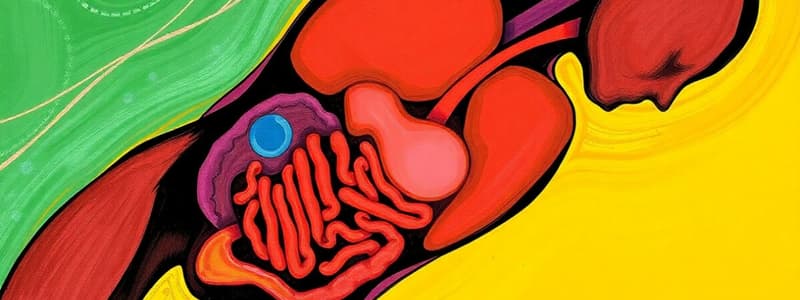Podcast
Questions and Answers
What is the primary function of the finger-like projections in the small intestine?
What is the primary function of the finger-like projections in the small intestine?
- To store excess glucose.
- To regulate the pH of the digestive system.
- To produce digestive enzymes.
- To increase the surface area for nutrient absorption. (correct)
Which enzyme aids in the digestion of proteins, breaking them down into amino acids?
Which enzyme aids in the digestion of proteins, breaking them down into amino acids?
- Trypsin (correct)
- Amylase
- Lipase
- Pepsin
Which characteristic distinguishes autotrophs from heterotrophs?
Which characteristic distinguishes autotrophs from heterotrophs?
- Autotrophs can synthesize their own food using sunlight or chemical energy. (correct)
- Autotrophs are primarily animals, while heterotrophs are plants.
- Autotrophs depend on other organisms for food.
- Autotrophs do not require energy to survive.
Which of the following statements accurately describes a key difference between arteries and veins?
Which of the following statements accurately describes a key difference between arteries and veins?
What products are formed during aerobic respiration?
What products are formed during aerobic respiration?
Which of the following is considered a metabolic waste product excreted by humans?
Which of the following is considered a metabolic waste product excreted by humans?
Besides kidneys, which other human organ is involved in excretion?
Besides kidneys, which other human organ is involved in excretion?
What best describes peristaltic movement?
What best describes peristaltic movement?
Flashcards
Functions of finger-like projections
Functions of finger-like projections
Increase surface area and absorb digested food in the small intestine.
Trypsin
Trypsin
An enzyme that aids protein digestion, secreted by the pancreas.
Lipase
Lipase
An enzyme that aids fat digestion, secreted by the pancreas.
Heterotrophs vs Autotrophs
Heterotrophs vs Autotrophs
Signup and view all the flashcards
Differences between arteries and veins
Differences between arteries and veins
Signup and view all the flashcards
Aerobic respiration
Aerobic respiration
Signup and view all the flashcards
Anaerobic respiration
Anaerobic respiration
Signup and view all the flashcards
Peristaltic movement
Peristaltic movement
Signup and view all the flashcards
Study Notes
Digestive System
-
Small Intestine Projections: Increase surface area for nutrient absorption and aid in absorbing digested food.
-
Trypsin and Lipase Role: Trypsin breaks down proteins into amino acids, while lipase breaks down fats into fatty acids and glycerol. Both enzymes are secreted by the pancreas.
Nutrition
- Heterotrophs vs. Autotrophs: Heterotrophs cannot produce their own food, relying on plants or animals (e.g., humans, animals). Autotrophs can produce their own food through photosynthesis (e.g., plants, algae).
Circulatory System
- Arteries vs. Veins: Arteries carry oxygen-rich blood under high pressure with thick, elastic walls. Veins carry carbon dioxide-rich blood under low pressure with thinner walls and valves.
Cellular Respiration
- Glucose Oxidation: Glucose is oxidized to produce energy through two processes: Aerobic respiration, which requires oxygen and produces energy, CO2, and water. Anaerobic respiration, which does not require oxygen and yields less energy and lactic acid.
Excretory System
-
Metabolic Wastes: Four main metabolic wastes produced by humans are carbon dioxide, urea, excess water, and salts.
-
Human Excretory Organs (besides kidneys): Lungs (remove CO2) and skin (remove sweat)
-
Peristaltic Movement: Wave-like muscle contractions in the food pipe and intestines that push food through the digestive system.
-
Desert Plant Stomata Closure: Desert plants close their stomata during the day to conserve water due to heat, opening them at night to perform CAM photosynthesis and store CO2 for daytime use.
Photosynthesis Significance
- Oxygen Production: Essential for respiration.
- Food Production: Primary energy source through glucose creation.
- Carbon Dioxide Balance: Absorption of CO2 and release of O2.
Blood Circulation
- Double Circulation: Blood circulates through the heart twice in a complete cycle, enabling efficient oxygenation and nutrient distribution.
Urine Formation
-
Urine Production Stages: Filtration (removes waste, water, and small molecules from blood), Reabsorption (recovers useful substances like glucose, water, and salts), and Secretion (adds excess wastes, toxins, and ions).
-
Urine Excretion: Filtered waste and excess materials exit the body through the urinary bladder and urethra.
Studying That Suits You
Use AI to generate personalized quizzes and flashcards to suit your learning preferences.




